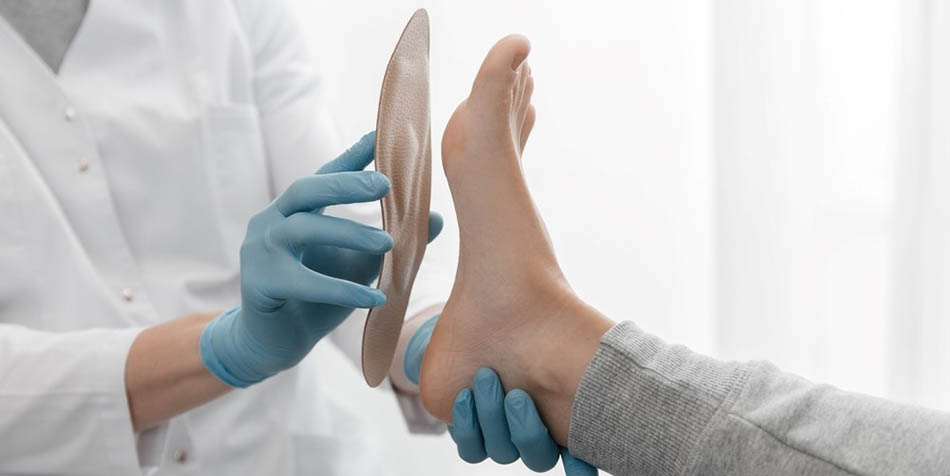
Finding the proper footwear is one simple change you can make to help manage chronic foot pain.
Our feet not only carry our entire body weight, but they also absorb the impact of every step we take. So, it's no surprise that many people experience foot pain from time to time. Chronic foot pain, on the other hand, can linger for months or even years, and it can sometimes be difficult to find relief. Fortunately, there are some simple lifestyle changes that can help.
What are the most common causes of foot pain?
There are a number of different things that can cause occasional foot pain, such as shoes that are too tight, overuse or injury. That type of pain usually goes away once the issue is addressed. Foot pain can also result from certain health conditions or structural issues like flat feet or fallen arches, says Dr. Gary Schmidt, a foot and ankle orthopedic surgeon with OrthoONE at Swedish Medical Center in Englewood, Colorado.
"One of the leading causes would be post-traumatic arthritis followed by general arthritic changes," Dr. Schmidt says. "Ankle fractures are very common problems, then changes in the mid-foot and great toe."
However, it can take time to notice these changes after they have already been present for a little while. "It's human nature. We hope to ignore it and have it go away, but oftentimes it will not," says Dr. Schmidt.
Foot pain can also come from electrical issues such as tarsal tunnel syndrome, which can cause chronic nerve pain. Tarsal tunnel is similar to carpal tunnel, which affects the hands and is caused by a pinched nerve. Although it is an uncommon cause of foot pain, tarsal tunnel is often underdiagnosed because its symptoms are similar to other foot conditions like plantar fasciitis.
What are the risk factors for chronic foot pain?
Athletes and highly active people often have a high risk of foot pain, Dr. Schmidt says. People who have suffered injuries, especially high-energy trauma injuries like motor vehicle accidents, are also likely to have foot pain as they regain their activity levels. Certain health conditions can also increase someone's risk of foot pain.
"Up to 30% of my patients with rheumatoid conditions come to me having foot and ankle chronic pain," Dr. Schmidt says. "People with generalized osteoarthritis will have a high proportion of foot and ankle pain. One has to remember that the ankle takes the most force of any of the weight-bearing joints in your body, so if you're predisposed to any of these conditions, oftentimes it will show up in your ankles or your feet."
When is foot pain a cause for concern?
Generally, chronic foot pain is pain that lasts for more than a few weeks or keeps returning. But what may be concerning for one person may not be a big deal for someone else.
"There's a difference between a nuisance and a problem. A nuisance is something that bothers you, but you do everything that you want to do anyway," Dr. Schmidt explains. "But a problem is something that prevents you from doing what you want to do. So if you simply have a nuisance, you might want to see how it goes and treat it yourself. But if it's indeed a problem, and you're not doing what you want to do because of it, that's when you need to have it looked into."
It's also important to take a careful inventory of what makes the foot hurt and when, as well as what makes it feel better. Some people may have pain that is worse at night while others may have pain that gets worse with activity. Being able to answer these questions can help the doctor determine the cause of the pain.
What lifestyle changes can help manage chronic foot pain?
If you have been dealing with foot pain for a while, it is possible to get relief with some lifestyle modifications. However, before you make any changes, you need to get an accurate diagnosis to make sure the right issues are being addressed. Some pain may be related to specific events or changes in your daily activities. For example, if you've started exercising more as a New Year's resolution and are experiencing foot pain, it might make sense to start at a lower fitness level and increase it as your body gets accustomed to the changes in activity.
Another simple change you can make is finding the proper footwear. Many people wear shoes that are too tight, which can cause pain, so wearing shoes that give the foot more space can help. Orthopedic shoes are specifically designed to support ankle, foot and leg structure. They are beneficial for people who suffer from plantar fasciitis, bunions, flat feet or other conditions that can affect the foot's structure and mechanics.
Many patients also get relief after starting a regular stretching program, Dr. Schmidt says, and physical therapy can be helpful too. Surgery is usually a last resort for foot pain because patients can often manage it with simple lifestyle changes. Only about 10% of foot pain solutions are surgical, Dr. Schmidt explains.
"We have a saying that everybody who comes into our barbershop isn't going to get a haircut. In other words, not everyone who's coming in is going to get an operation," he says.
Foot pain doesn't have to stop you from living your life. If it gets to a point where it becomes difficult or impossible for you to function, it's important to talk to your doctor to find a solution.
Dr. Schmidt adds, "I often say to my patients, 'This isn't the dress rehearsal for your next life. This is it. So you should be doing the things you want to do.'"
$webqFacilityNumber
Need a Physician?